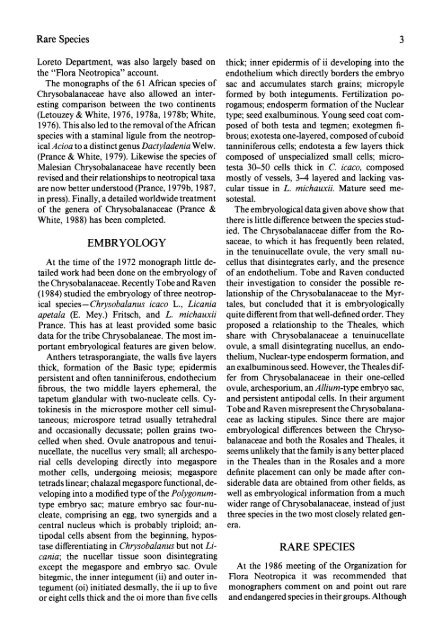flora neotropica - CNCFlora
flora neotropica - CNCFlora
flora neotropica - CNCFlora
You also want an ePaper? Increase the reach of your titles
YUMPU automatically turns print PDFs into web optimized ePapers that Google loves.
Rare Species 3<br />
Loreto Department, was also largely based on thick; inner epidermis of ii developing into the<br />
the "Flora Neotropica" account.<br />
endothelium which directly borders the embryo<br />
The monographs of the 61 African species of sac and accumulates starch grains; micropyle<br />
Chrysobalanaceae have also allowed an inter- formed by both integuments. Fertilization poesting<br />
comparison between the two continents rogamous; endosperm formation of the Nuclear<br />
(Letouzey & White, 1976, 1978a, 1978b; White, type; seed exalbuminous. Young seed coat com-<br />
1976). This also led to the removal of the African posed of both testa and tegmen; exotegmen fispecies<br />
with a staminal ligule from the neotrop- brous; exotesta one-layered, composed of cuboid<br />
ical Acioa to a distinct genus Dactyladenia Welw. tanniniferous cells; endotesta a few layers thick<br />
(Prance & White, 1979). Likewise the species of composed of unspecialized small cells; micro-<br />
Malesian Chrysobalanaceae have recently been testa 30-50 cells thick in C. icaco, composed<br />
revised and their relationships to <strong>neotropica</strong>l taxa mostly of vessels, 3-4 layered and lacking vasare<br />
now better understood (Prance, 1979b, 1987, cular tissue in L. michauxii. Mature seed mein<br />
press). Finally, a detailed worldwide treatment sotestal.<br />
of the genera of Chrysobalanaceae (Prance & The embryological data given above show that<br />
White, 1988) has been completed.<br />
there is little difference between the species studied.<br />
The Chrysobalanaceae differ from the Ro-<br />
EMBRYOLOGY<br />
saceae, to which it has frequently been related,<br />
in the tenuinucellate ovule, the very small nu-<br />
At the time of the 1972 monograph little de- cellus that disintegrates early, and the presence<br />
tailed work had been done on the embryology of of an endothelium. Tobe and Raven conducted<br />
the Chrysobalanaceae. Recently Tobe and Raven their investigation to consider the possible re-<br />
(1984) studied the embryology of three neotrop- lationship of the Chrysobalanaceae to the Myrical<br />
species-Chrysobalanus icaco L., Licania tales, but concluded that it is embryologically<br />
apetala (E. Mey.) Fritsch, and L. michauxii quite different from that well-defined order. They<br />
Prance. This has at least provided some basic proposed a relationship to the Theales, which<br />
data for the tribe Chrysobalaneae. The most im- share with Chrysobalanaceae a tenuinucellate<br />
portant embryological features are given below. ovule, a small disintegrating nucellus, an endo-<br />
Anthers tetrasporangiate, the walls five layers thelium, Nuclear-type endosperm formation, and<br />
thick, formation of the Basic type; epidermis an exalbuminous seed. However, the Theales difpersistent<br />
and often tanniniferous, endothecium fer from Chrysobalanaceae in their one-celled<br />
fibrous, the two middle layers ephemeral, the ovule, archesporium, an Allium-type embryo sac,<br />
tapetum glandular with two-nucleate cells. Cy- and persistent antipodal cells. In their argument<br />
tokinesis in the microspore mother cell simul- Tobe and Raven misrepresent the Chrysobalanataneous;<br />
microspore tetrad usually tetrahedral ceae as lacking stipules. Since there are major<br />
and occasionally decussate; pollen grains two- embryological differences between the Chrysocelled<br />
when shed. Ovule anatropous and tenui- balanaceae and both the Rosales and Theales, it<br />
nucellate, the nucellus very small; all archespo- seems unlikely that the family is any better placed<br />
rial cells developing directly into megaspore in the Theales than in the Rosales and a more<br />
mother cells, undergoing meiosis; megaspore definite placement can only be made after contetrads<br />
linear; chalazal megaspore functional, de- siderable data are obtained from other fields, as<br />
veloping into a modified type of the Polygonum- well as embryological information from a much<br />
type embryo sac; mature embryo sac four-nu- wider range of Chrysobalanaceae, instead ofjust<br />
cleate, comprising an egg, two synergids and a three species in the two most closely related gencentral<br />
nucleus which is probably triploid; an- era.<br />
tipodal cells absent from the beginning, hypostase<br />
differentiating in Chrysobalanus but not Li-<br />
RARE SPECIES<br />
cania; the nucellar tissue soon disintegrating<br />
except the megaspore and embryo sac. Ovule At the 1986 meeting of the Organization for<br />
bitegmic, the inner integument (ii) and outer in- Flora Neotropica it was recommended that<br />
tegument (oi) initiated desmally, the ii up to five monographers comment on and point out rare<br />
or eight cells thick and the oi more than five cells and endangered species in their groups. Although

















